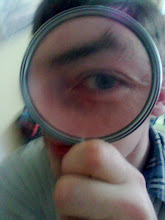- Your "copy transform" chapbook from the "Visual Shareware" series is my favourite. Can you tell us something about the brochure, about the blue version, and about the whole series?
For copy transform I took some of my typographic work and put it on a small table photocopier machine. I was quite impressed how the impact changed in comparison to the original works.
When doing the photocopies I wished I could also print in Blue with the photocopier, but I didn’t could get blue toner for my machine. Later when I got in touch with mimeo printing I could realize it with a second edition, "copy transform - blue version".
Recently I found an old spirit duplicator and I printed a third edition with it, "copy transform - spirit version".
Funny thing it was not my plan to make this editions when I created the photocopier version. This is in fact quite typical for my working, things happen and my work is developing unforeseen.
- I would like to ask you about the meta level - sometimes you type about typing, and for example the title "Is there a Plan behind the Plan" also sounds interesting in the meta level context. Do you take notes on what projects you are planning?
Actually, I don't really plan my work, I sometimes make a short note of ideas - but just not to forget them again.
The meta-level usually comes later - for example when I'm looking for a title. I always hang my works on the pinboard after their creation and communicate with them, so to speak.
I find it interesting myself what associations, cross connections and meta levels arise.
- It's interesting to read the explanations of the technique used on your publications (for example "dry transfer lettering on white lines"). Are these just notes, or should they influence the reader?
For me, the used technique is an essential part of the creation of my work. I’m experimenting with outdated printing and duplication techniques — and that is sometimes reflected in the title.
I think it does something to the viewer, at least it's an explanation.
- What do you think about tradition, regarding old writing and printing machines and techniques?
I’m just fascinated by these old print making techniques and machines.
Doing by hand, slowly. ;)
- Is using the backside of the font more encryption or censorship?
Interesting question, could definitely be both. I don’t want to decide that - at the end it is unreadable!
It’s just an example for finding a meta level: But this is another nice example of the meta-level that can arise.
Actually, I print the backs of the letters first of all because of their geometric shape, and the constructions that can be created from them. But these backs also often have a beautiful structure.
When I printed the backs of the metal type letters, for example, I noticed that the perforated structure of the feet often looks like galaxies. This resulted in the title of the series, "The Backside of the Universe".
- You exhibit your works in many places. How do you find places to exhibit?
For me, the exchange with like-minded artists is important — and extremely inspiring. And I found my concrete poetry community mainly through the social networks. There is it, where I exhibit my work :)
Sometimes I am also invited to exhibitions in the real world then.
- Can you tell us something about ToCall?
Last year I found an antiquarian copy of the last edition of Tlaloc published by Cavan McCarthy in the 1970s. At that time there were many such anthological, periodical, independent magazines in which poets and artists could publish their works.
I was extremely fascinated by the idea and simplicity - and it was printed on the mimeograph.
I was just so excited that I decided to print a magazine about visual and concrete poetry on my mimeograph.
- You sometimes concentrate on the shape of poems. Are you searching for new forms, or do you want the reader to notice the form?
Since I’m interested not only in letters but also in geometrics, indeed, I want the reader to notice the form of texts and poems.
- I'm interested in the sphere where poetry and comics overlap - it's mostly visible between experimental comics and visual poetry (I call it neopoemics). Do you like it when arts meet?
For sure, I like the discovery of new spheres.
With printing typographics I found my way in the field between art and literature - and that’s great!
- Which do you prefer: the square, or the A4 format? And why?
I prefer the technically more suitable. For the typewriter I often choose the square because I can then turn the page.
For my mimeograph, the A4 format is the most effective, then I don't have to cut anything. And the A4 paper is often cheaper.
https://pswgallery.tumblr.com/tagged/backside-of-the-universe
www.psw.gallery







Brak komentarzy:
Prześlij komentarz